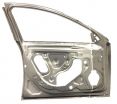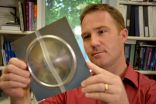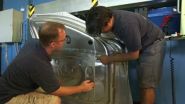(Press-News.org) RICHLAND, Wash - Researchers have demonstrated a new process for the expanded use of lightweight aluminum in cars and trucks at the speed, scale, quality and consistency required by the auto industry. The process reduces production time and costs while yielding strong and lightweight parts, for example delivering a car door that is 62 percent lighter and 25 percent cheaper than that produced with today's manufacturing methods.
In partnership with General Motors, Alcoa and TWB Company LLC, researchers from the Department of Energy's Pacific Northwest National Laboratory have transformed a joining technique called friction stir welding, or FSW. The technique now can be used to join aluminum sheets of varying thicknesses, which is key to producing auto parts that are light yet retain strength where it's most needed. The PNNL-developed process also is ten times faster than current FSW techniques, representing production speeds that, for the first time, meet high-volume assembly requirements. The advancement is reported in the May issue of JOM, the member journal of The Minerals, Metals & Materials Society.
"We looked at the barriers preventing the use of more lightweight alloys in cars, picked what we felt was a top challenge, and then formulated a team that represented the entire supply chain to tackle it," said Yuri Hovanski, the program manager at PNNL and lead author. "The result is a proven process that overcomes the speed, scale and quality limitations of FSW that previously were showstoppers for the auto industry."
The two-phase, six-year project is funded by the Department of Energy's Office of Energy Efficiency and Renewable Energy with in-kind partner contributions from each of the participating companies.
Aluminum can't take the heat
To create door frames, hoods and other auto parts, sheets of metal are welded together end-to-end into a "tailor-welded blank" which is then cut into appropriate sizes before being stamped into the final shape. This process allows a high degree of customization. For example, a thicker gauge of metal can be used on one side of a car part, where extra strength is needed, joined via a weld to a thinner gauge on the side where it's not.
Conventional laser welding works great to join varying thicknesses of steel, but can be problematic when applied to aluminum due to the reactivity of molten aluminum to air. Instead, manufacturers today must create several components from single sheets that are then riveted together after being stamped, resulting in additional production steps and more parts that drive up cost and weight.
"Reducing the weight of a vehicle by 10% can decrease fuel consumption by 6%-8%, so the auto industry is very interested in a welding technique such as FSW that is aluminum friendly," Hovanski said.
Mixed, not melted
A friction-stir welding machine looks and acts like a cross between a drill press and a sewing machine. Lowered onto two metal sheets sitting side-by-side, the "drill bit," or in this case pin tool, spins against both edges. As it travels along, the pin creates friction that heats, mixes and joins the alloys without melting them. By auto industry production standards, however, the process was too slow - just one-half meter welded per minute - which is why the technique has been used only in niche applications, if at all.
Supply chain success
Hovanski and colleagues at PNNL initially compared several joining techniques before selecting FSW, which was the only one to pass all of GM's rigorous weld quality specifications. Researchers then conducted a comprehensive series of lab-scale welding tests on aluminum sheets provided by Alcoa.
In all, dozens of unique tool designs with varying shapes, lengths and diameters of the pin were created. These were assessed against a variety of weld parameters, such as the depth, rotation speed and angle of the tool. Through statistical analysis, the team identified the optimal combination of tool specification and weld parameters that could consistently withstand high-speed production demands.
"What we discovered was a win-win," Hovanski said. "The faster the weld, the better the quality and strength of the join, thus the significant increase in speed."
PNNL provided the weld and tool specifications to TWB Company and GM. TWB Company then independently welded, formed and analyzed more than 100 aluminum blanks in close coordination with GM, making them the first qualified supplier of aluminum tailor-welded blanks. GM subsequently stamped their first full-sized inner door panel supplied by TWB Company -- free of imperfections -- from aluminum sheets in varying thicknesses.
Today, TWB Company has a dedicated FSW machine at their production facility in Monroe, MI, built around PNNL's process that is capable of producing up to 250,000 parts per year. "TWB can now provide aluminum tailor welds not only to GM, but the entire automotive industry," said Blair Carlson, a group manager at GM who con-conceptualized the project.
Next up
With over two years of funding left, the team continues to collaborate, with a focus on even faster weld speeds and the ability to maneuver around the contours and corners of complex aluminum parts, for which laser welding is not commercially feasible. The team also is modifying FSW to join different alloys, such as automotive-grade aluminum alloys with light, ultra-high strength alloys currently reserved for aerospace applications.
"Going forward, we see this process, and future versions of it, enabling completely novel combinations of materials that will revolutionize material use in the auto industry," Hovanski said.
INFORMATION:
Reference: Y. Hovanski, P. Upadhyay, J. Carsley, T. Luzanski, B. Carlson, M. Eisenmenger, A. Soulami, D. Marshall, B. Landino, S. Hartfield-Wunsch. High-speed friction-stir welding to enable aluminum tailor-welded blanks, JOM, April 2, 2015, DOI:10.1007/s11837-015-1384-x
About PNNL
Interdisciplinary teams at Pacific Northwest National Laboratory address many of America's most pressing issues in energy, the environment and national security through advances in basic and applied science. Founded in 1965, PNNL employs 4,300 staff and has an annual budget of more than $1 billion. It is managed by Battelle for the U.S. Department of Energy's Office of Science. As the single largest supporter of basic research in the physical sciences in the United States, the Office of Science is working to address some of the most pressing challenges of our time. For more information on PNNL, visit the PNNL News Center, or follow PNNL on Facebook, Google+, LinkedIn and Twitter.
Young children who hear more than one language spoken at home become better communicators, a new study from University of Chicago psychologists finds. Effective communication requires the ability to take others' perspectives. Researchers discovered that children from multilingual environments are better at interpreting a speaker's meaning than children who are exposed only to their native tongue. The most novel finding is that the children do not even have to be bilingual themselves; it is the exposure to more than one language that is the key for building effective social ...
New research published in Nature Communications led by Meiyun Lin of NOAA's Geophysical Fluid Dynamics Laboratory and NOAA's cooperative institute at Princeton University, reveals a strong connection between high ozone days in the western U.S. during late spring and La Niña, an ocean-atmosphere phenomena that affects global weather patterns.
Recognizing this link offers an opportunity to forecast ozone several months in advance, which could improve public education to reduce health effects. It would also help western U.S. air quality managers prepare to track these ...
LAWRENCE -- Political discussions conducted on social networking sites like Facebook mirror traditional offline discussions and don't provide a window into previously untapped participants in the political process, according to a new study that includes two University of Kansas researchers.
"Social networking is important, but what we've shown in political science is that the people who are using the Internet, be it Facebook, Twitter or whatever else for political activities, are really the same people who are politically active offline anyway," said Patrick Miller, a ...
AURORA, Colo. (May 12, 2015) - A team of neuroscientists and bioengineers at the University of Colorado Anschutz Medical Campus have created a miniature, fiber-optic microscope designed to peer deeply inside a living brain.
The researchers, including scientists from the University of Colorado Boulder, published details of their revolutionary microscope in the latest issue of Optics Letters journal.
"Microscopes today penetrate only about one millimeter into the brain but almost everything we want to see is deeper than that," said Prof. Diego Restrepo, PhD, one of the ...
A study of 2,377 children with autism, their parents and siblings has revealed novel insights into the genetics of the condition.
The findings were reported May 11 in Nature Genetics.
By analyzing data from families with one child with autism and one or more children without the condition, the researchers collected new information on how different types of mutations affect autism risk. The genetic data was obtained from exome sequencing, which looks at only the protein-coding portions of the genome.
Significant progress in the past five years has been made in ...
The fixed-dose combination aclidinium bromide/formoterol has been approved since November 2014 for long-term treatment of adults with chronic obstructive pulmonary disease (COPD). The German Institute for Quality and Efficiency in Health Care (IQWiG) examined in a dossier assessment whether this drug combination offers an added benefit over the appropriate comparator therapy.
According to the findings, there is an indication of minor added benefit for adult patients with moderate COPD (grade II). For adults with grade III and fewer than 2 exacerbations (flare-ups) per ...
Male HIV patients in rural South Africa reach the low immunity levels required to become eligible for antiretroviral treatment in less than half the time it takes for immunity levels to drop to similar levels in women, according to new research from the University of Southampton.
Researchers also found a link between potential proxy measures of nutritional status and disease progression, with those reporting food shortages and use of nutritional supplements reaching lower levels of immunity faster.
CD4 cell count is a measure of the immune system which indicates the ...
They are 'strange' materials, insulators on the inside and conductors on the surface. They also have properties that make them excellent candidates for the development of spintronics ('spin-based electronics') and more in general quantum computing. However, they are also elusive as their properties are extremely difficult to observe. Now a SISSA study, published in Physical Review Letters, proposes a new family of materials whose topological state can be directly observed experimentally, thus simplifying things for researchers.
"What interests us of topological insulators ...
A gap year between high school and the start of university studies does not weaken young people's enthusiasm to study or their overall performance once the studies have commenced. On the other hand, adolescents who continue to university studies directly after upper secondary school are more resilient in their studies and more committed to the study goals. However, young people who transfer directly to university are more stressed than those who start their studies after a gap year. These research results have been achieved in the Academy of Finland's research programme ...
In a study published this month in Malaria Journal, researchers from Uppsala University and other institutions present a new model for systematically evaluating new malaria treatment programs in routine conditions across multiple countries.
Despite major investments in malaria rapid diagnostic tests (RDT) in recent years, there remains limited evidence of their impact on treatment decisions in routine program conditions. Evidence to date is largely derived from small-scale facility studies conducted within a limited number of countries, notably Kenya, Malawi, Tanzania, ...




